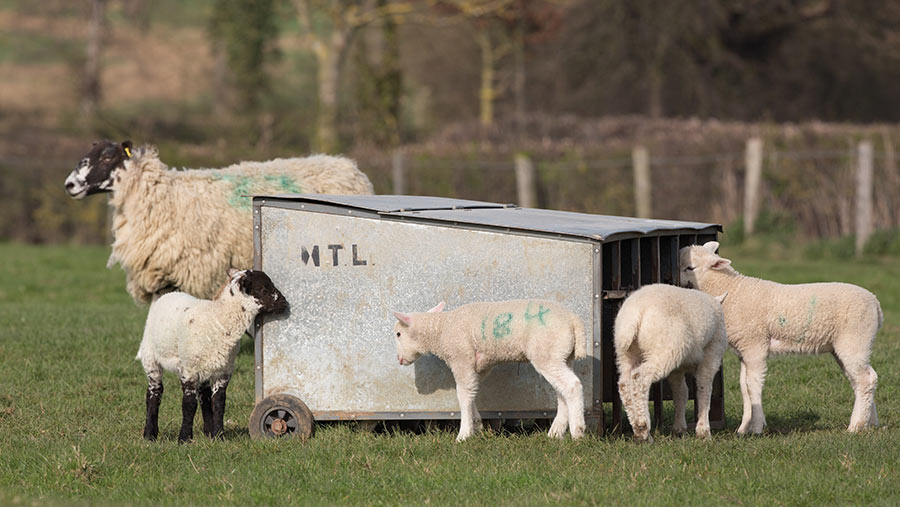Advice on feeding creep to lambs efficiently
 © Tim Scrivener
© Tim Scrivener Creep feed adds to the cost of production, but for farmers chasing higher lamb prices from the early market, the economics of concentrate feeding can stack up.
Farmers targeting early sales can recoup their investment in supplementary feeding by selling when supply is tighter and prices higher.
Strategic feeding can also make up for a shortfall of grass, says independent sheep specialist Lesley Stubbings.
Below, she offers advice on how creep feeding should be done.
See also: 6 things to consider when feeding lambs milk replacer
When should creep be offered?
Introduce creep when lambs are two to three weeks old. By the time twins are three weeks old, they need to be taking in feed of their own, on top of the ewe’s milk, if they are to continue to grow fast. If the grass isn’t there then creep can fill this gap.
When sward height exceeds 4cm there is sufficient dry matter available to meet the nutritional needs of ewes and lambs, but it must be consistently at that height.
A mistake some sheep farmers make is to not offer it soon enough and therefore they don’t achieve that extra daily liveweight gain for early finishing.
Quite often farmers are hesitant to feed creep to young lambs, preferring to wait until they are weaned, but at that point, their feed conversion rate (FCR) is declining rapidly and they have already lost out on potential weight gain.
What FCR can you expect?
The FCR in young lambs is about 3.5:1 – for every 3.5kg of creep eaten the lamb will gain 1kg.
Efficient FCR is a big plus in young lambs – post-weaning this drops to 7:1 and keeps falling.
Will I need to keep feeding concentrates once lambs have a taste for it?
No, you can use it to fill a gap early in the grazing season for a short period, if you need it to maintain growth until there is enough grass for ewes and lambs.
If you are going to drop it off again just remember to make a decision before they are too dependent on creep. Lambs might become reliant on creep once they are eating more than 500g a head a day, so remove it when they are eating less than 500g – this would be when lambs are about seven to nine weeks of age.
If you are going to creep feed all the way through to finishing then set the target of finishing at least 70% of lambs by the second week in July. This is when prices would normally start to dip as grass-fed lambs start to come on to the market.
You don’t have to creep feed the whole flock either – it may be that only a proportion are short of dry matter and need to be supplemented.
How much should be offered?
Creep is expensive so aim to feed a minimum of the best quality product and give lambs ad-lib access.
The supply needs to be consistent and fresh. You don’t want any waste, but you must always avoid a situation where the lambs have eaten all the creep and are without it, because there is the risk they may gorge when the feeders are filled up again.
What weight gain can I expect?
A benchmark daily growth rate for twin lambs in lowland flocks up to eight weeks is 300g, but on creep you should expect it to be nearer to 350-400g/day.
What ingredients would I expect to find in a good quality creep feed?
First, make sure it is a creep that has been formulated specifically for lambs in small 3mm pellets. Don’t just feed ewe or hogget nuts.
It is a big mistake to focus on cost and buy something that is designed for older animals: high-quality lamb creep is critical for performance.
A lamb creep should be 18% crude protein and high in energy. When the lambs are eating a lot of creep, after about nine weeks old, you can reduce the cost by swapping to a 16% crude protein product, providing it is still good quality.
The ingredients on the label are listed in descending order. Molasses will normally be 4-6% (towards the bottom of the list). The main ingredients to look for are cereals, sugar beet and/or distiller’s pellets, Hipro soya, and possibly some maize.
An alternative to buying a ready-made creep is to mix your own with cereals, sugar beet, and a protein pellet or Hipro soya, peas or beans. This might suit farmers who have dairy cows, for example, who already have straights on the farm.
Where is the best place to position creep feeders?
Site feeders somewhere sheltered where there is hard standing, if possible.
If you can move them to avoid areas getting muddy then that is ideal, but this can be difficult in practice because they are heavy when full and you don’t want to let them become empty.
Are there any health risks to be aware of?
Creep feeding can increase the risk of coccidiosis because you are bringing lambs together in a concentrated area.
If you haven’t fed creep before this is something to keep an eye on.
The risk of coccidiosis can be minimised with good management. For example, making sure lambs are run in tight age groups and avoiding repeated, sequential use of nursery paddocks.
Make sure you are familiar with the symptoms. These include diarrhoea (sometimes containing blood or mucus), dehydration, fever, inappetence, weight loss, anaemia, wool breaking, and death. You may want to discuss the treatments available with your vet and possibly the use of a coccidiostat.
Also, watch out for the nematodirus forecast (scops.org.uk/nematodirus) and make sure you take action if lambs are at risk.
Thanks to Volac, whose sponsorship made it possible to run this article. Farmers Weekly had full editorial control of this report.
About Volac:
 Thanks to a range of innovative Volac feeding equipment, surplus lambs can now be reared very successfully without all the inherent practical problems of fostering on to an unwilling ewe. And by correctly mixing and feeding 9 to 11 litres of Volac’s independently proven Lamlac ewe milk replacer from birth until weaning, you’ll produce good quality lambs, earn a decent margin over feed costs, as well as save hours of effort and hassle.
Thanks to a range of innovative Volac feeding equipment, surplus lambs can now be reared very successfully without all the inherent practical problems of fostering on to an unwilling ewe. And by correctly mixing and feeding 9 to 11 litres of Volac’s independently proven Lamlac ewe milk replacer from birth until weaning, you’ll produce good quality lambs, earn a decent margin over feed costs, as well as save hours of effort and hassle.
Lamlac – proven, market-leading performance for over 50 years.
